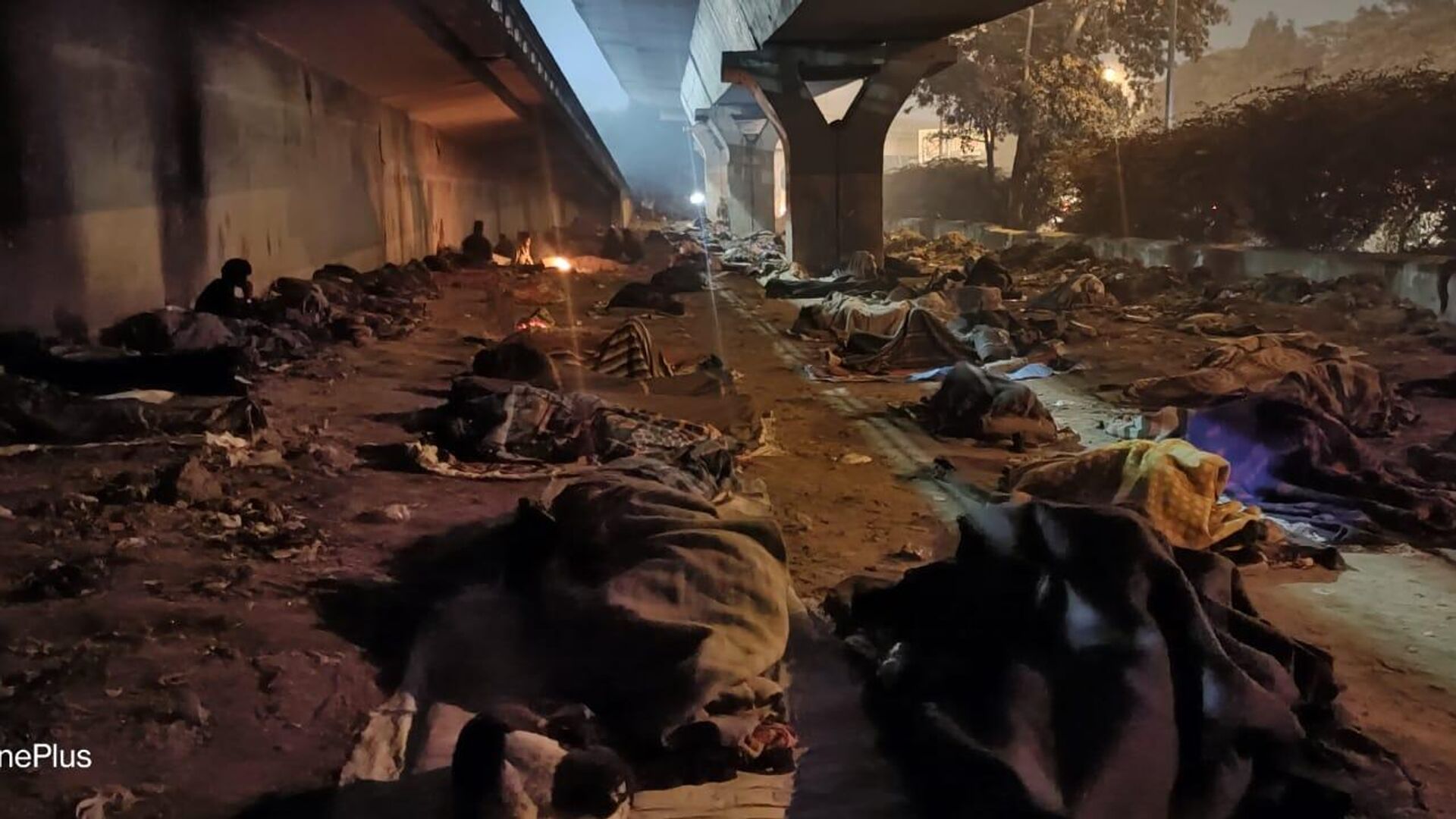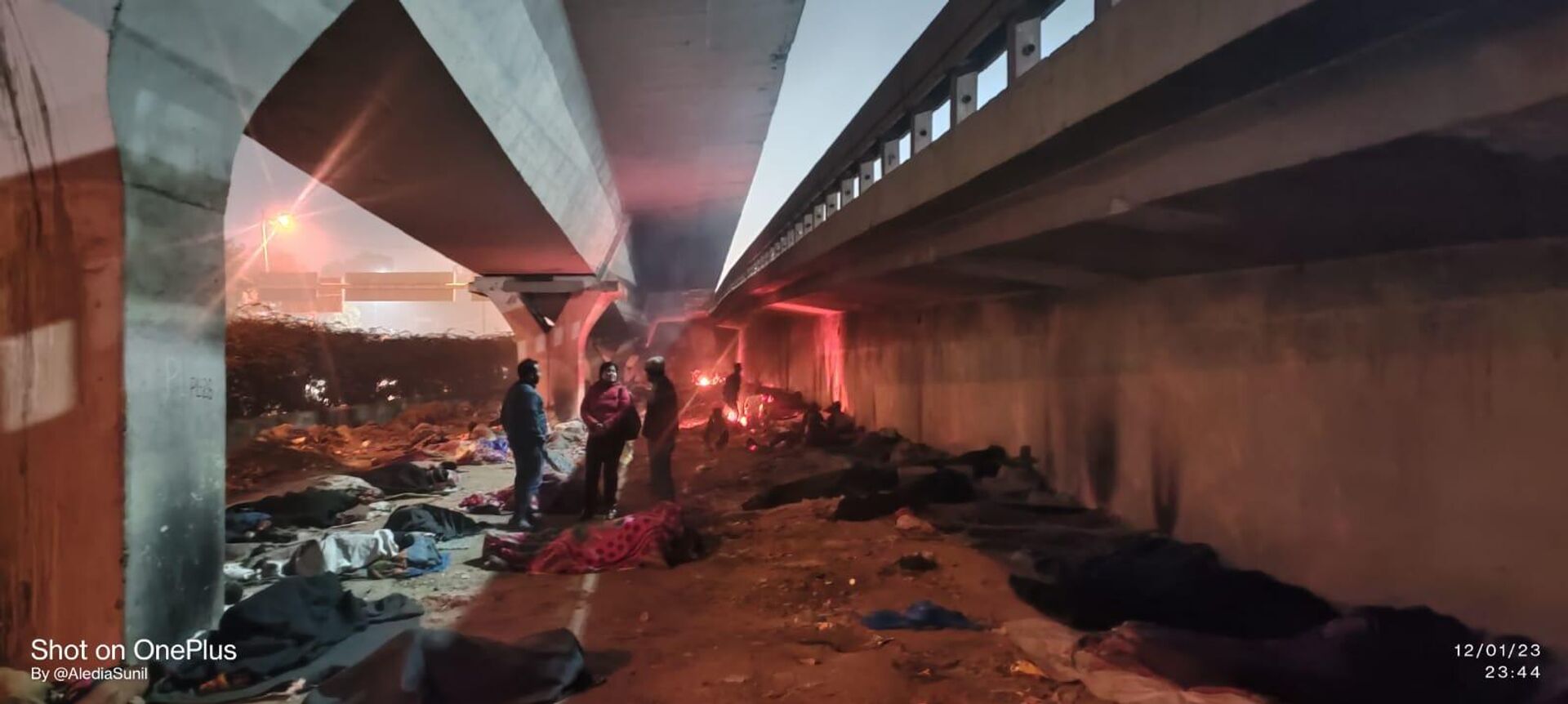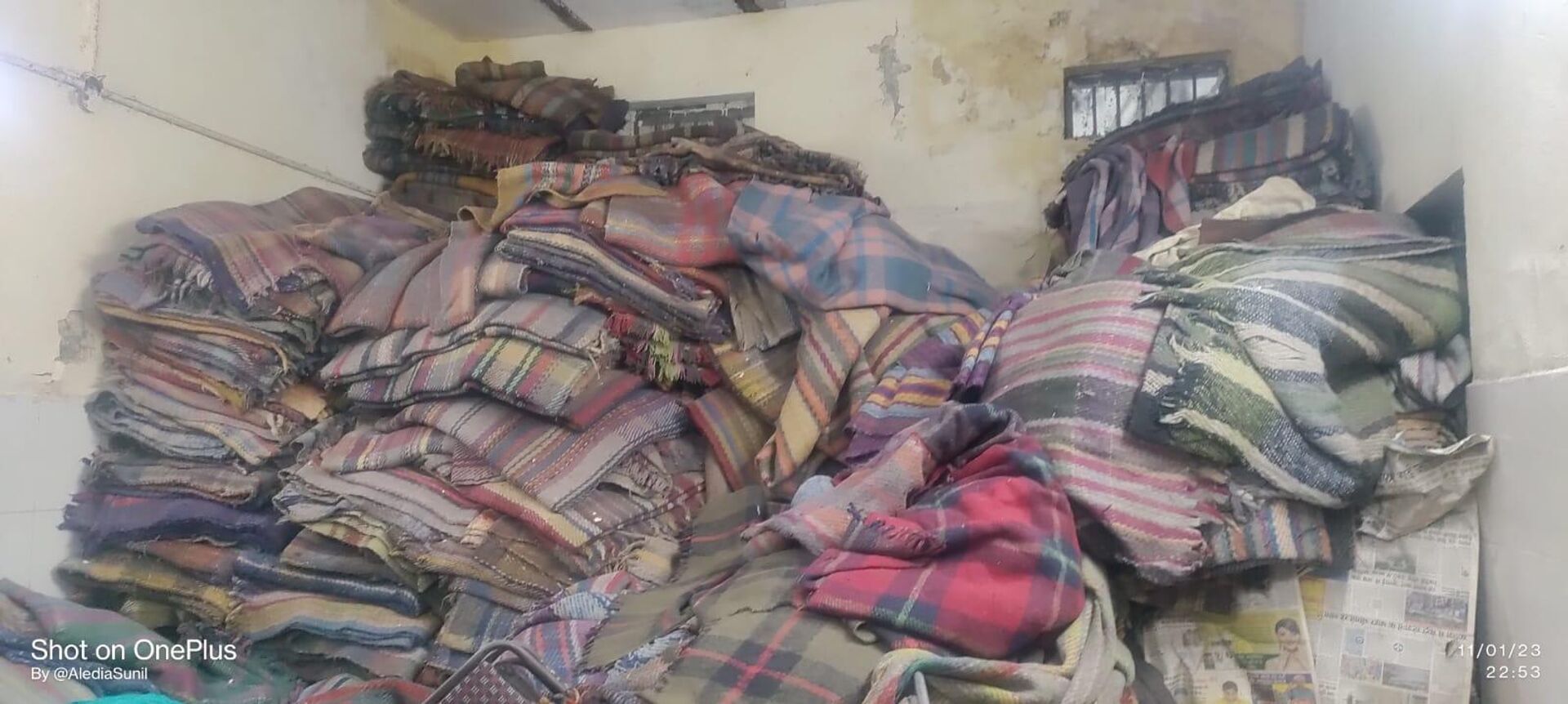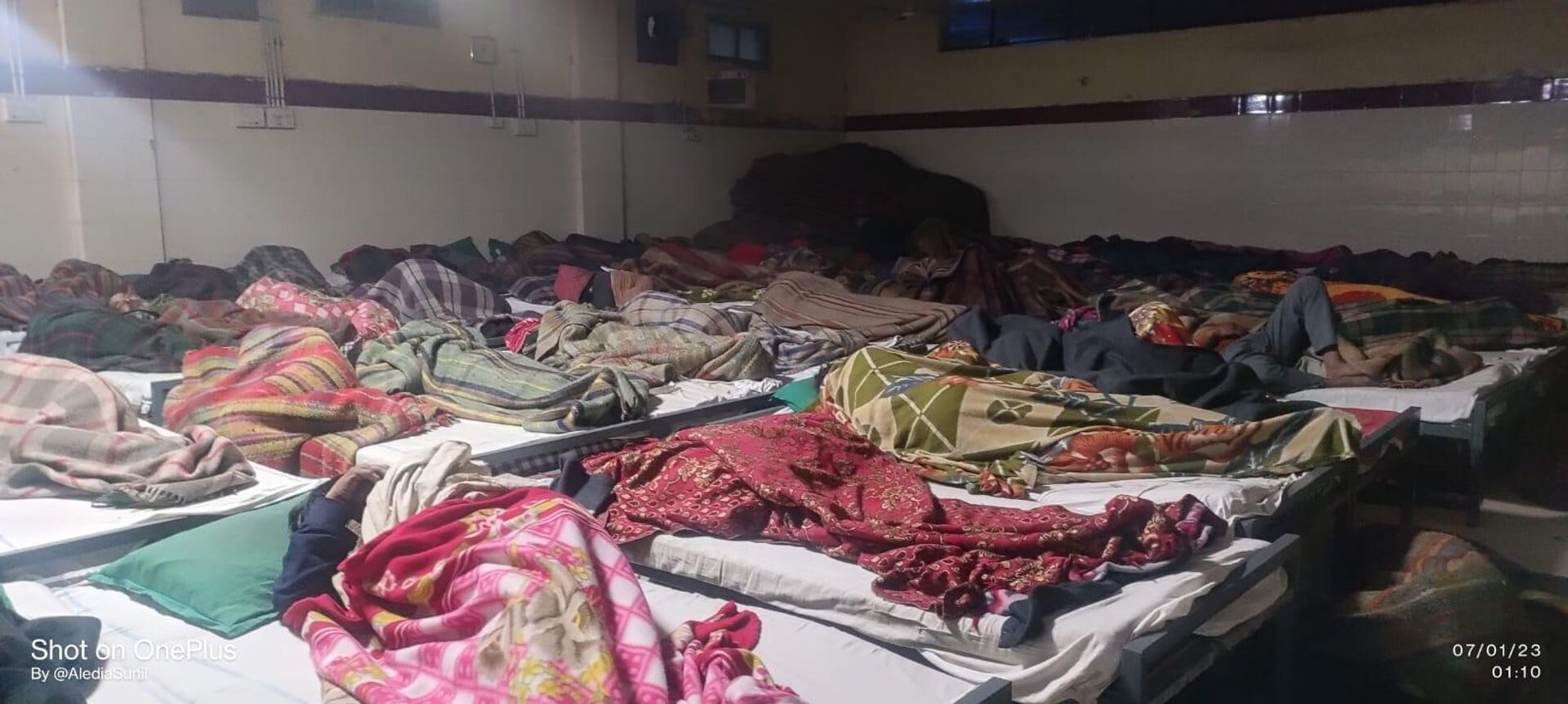https://sputniknews.in/20230118/with-torn-blankets--bedbugs-delhi-homeless-prefer-sleeping-on-streets-528803.html
With Torn Blankets & Bedbugs, Delhi Homeless Prefer Sleeping on Streets
With Torn Blankets & Bedbugs, Delhi Homeless Prefer Sleeping on Streets
Sputnik India
Sputnik has learned that Delhi homeless shelters are already full, forcing people to sleep outdoors, while police don't even register frozen corpses found in... 18.01.2023, Sputnik India
2023-01-18T12:00+0530
2023-01-18T12:00+0530
2023-01-18T12:59+0530
delhi
delhi police
sputnik exclusives
homeless people
india
cold weather
https://cdn1.img.sputniknews.in/img/07e7/01/11/529762_161:0:1439:719_1920x0_80_0_0_b75f8150da8b9385bbd50d5c54e955b3.jpg
Every winter, when the temperature drops to around 8 degrees and nights get freezing, most of the migrants turn to state shelter homes in Delhi.But despite the government providing a closed shelter with beds, mattresses, and blankets, many prefer to sleep in the streets.As chilling cold grips Delhi, where can homeless men find shelter?In north Delhi, especially around Yamuna Pushta and Kashmiri Gate, homeless people can be easily spotted sleeping on the sidewalks with a blanket to protect themselves from chilling cold. A few can be found sitting around smoldering fires, lit with garbage and discarded boxes.Many of these people either drink liquor or even take drugs to fall asleep easily, and try to ignore the harsh weather.Last week, the city's minimum temperature dropped to as low as 1.4 degrees Celsius — however, fresh weather forecasts suggest it might even drop to zero.So far, this January has been one of the coldest winters in the past nine years; since 2013. Generally, New Delhi's annual temperature is between 13 and 33 degrees Celsius, except during heatwaves and cold spells.Meanwhile, about 47,000 in Delhi are homeless, India's 2011 census figures tell. However, as the census was delayed to the pandemic, social activists claim that this number is now about 150,000.Sputnik spoke with the homeless inside the shelters and those who were sleeping on the sidewalks to understand the situation.50-year-old Subhash Kumar, a daily worker who sleeps on the sidewalk in the east Delhi area, shared his traumatic story with Sputnik correspondents."And I keep moving for work in different parts of Delhi. Now, how do I know which is a nearby shelter home, and do they have vacant place to adjust me for the day?", he wondered.Kumar, who hails from West Bengal, said that he has been living in Delhi for 35 years. He married once in his life, but his wife left him a long time ago.Although the Delhi government claims that it now has about 300 shelter homes, this remains debatable, especially given that the authorities cannot share the overall capacities of these shelter homes.It is believed that these shelter home can accommodate about 27,000 people.Police Don't Register Frozen Corpses Found in the StreetsDelhi Police data suggests that as of January 17, the authorities have discovered more than 125 unidentified dead bodies in Delhi; 95% of them are homeless people.However, the Delhi government refuses to confirm they died due to the persisting chill."We also released an advertisement in a local newspaper titled "Appeal for Identification." When no one comes for 7-10 days, last rites are performed as per the procedure."NGOs suggest 145 people died in January last year – although the Delhi government calls the data "fake" and "fabricated." In December, 162 dead bodies were found in the streets of Delhi, all believed to have been of the homeless.No New Blankets Brought By Delhi Gov't Since 201461-year-old Pawan Kumar, a migrant laborer from Agra in Uttar Pradesh, said he never slept inside a night shelter since they are usually dirty, smelly, and have rats and bedbugs, while the blankets there are dirty.This is the first time in his life that he's registered himself at the Kashmere Gate shelter home since the risk of getting sick has gotten more acute as he has gotten older.Fatehpuri Shelter Home, situated in Old Delhi, which is capable of accommodating 450 people, is among the largest shelter homes in Delhi. Here, two people were seen sharing 6X3 feet beds, as occupancy remains full.Many have complained about torn blankets or blankets not being enough to protect them from cold. But caretakers at all the shelter homes prefer to stay quiet and requested that they not be quoted.Sunil Kumar Aledia, founder of CHD, who has worked with the city's homeless for many years, shared: "That problem lies at many levels. And, we need to handle the situation from a humanitarian angle than make some policy to fit everyone.""At present, it seems the government wants to increase the number of shelter homes in the papers and shed away with their duties," Aledia said.The officials hardly seem to be concerned with the conditions of running a shelter home.In December, Lieutenant Governor V. K. Saxena visited the ISBT Kashmere Gate Shelter Home area and found hundreds of people sleeping outside shelters and "unsanitary" conditions inside shelters and adjoining toilets.He later "shunted" the CEO of the Delhi Urban Shelter Improvement Board, who is responsible for maintaining shelter homes for the homeless."But what after this one visit? Was any policy change, or if a temporary shelter home built after the incident? Transferring officials is the easiest way, always," Aledia remarked. Meanwhile, Sputnik also tried to contact DUSIB's CEO to speak on the condition of night shelters, but she has yet to answer the request.
delhi
india
Sputnik India
feedback.hindi@sputniknews.com
+74956456601
MIA „Rossiya Segodnya“
2023
Deexa Khanduri
https://cdn1.img.sputniknews.in/img/07e6/0c/13/138923_52:0:533:481_100x100_80_0_0_cadf23d341691fc65ff2b22fd1afe584.jpg
Deexa Khanduri
https://cdn1.img.sputniknews.in/img/07e6/0c/13/138923_52:0:533:481_100x100_80_0_0_cadf23d341691fc65ff2b22fd1afe584.jpg
News
en_IN
Sputnik India
feedback.hindi@sputniknews.com
+74956456601
MIA „Rossiya Segodnya“
Sputnik India
feedback.hindi@sputniknews.com
+74956456601
MIA „Rossiya Segodnya“
Deexa Khanduri
https://cdn1.img.sputniknews.in/img/07e6/0c/13/138923_52:0:533:481_100x100_80_0_0_cadf23d341691fc65ff2b22fd1afe584.jpg
delhi homeless, torn blankets, deadbugs, homeless, pavements of delhi, street of delhi, delhi winter, delhi homeless
delhi homeless, torn blankets, deadbugs, homeless, pavements of delhi, street of delhi, delhi winter, delhi homeless
With Torn Blankets & Bedbugs, Delhi Homeless Prefer Sleeping on Streets
12:00 18.01.2023 (Updated: 12:59 18.01.2023) Deexa Khanduri
Sputnik correspondent
Sputnik has learned that Delhi homeless shelters are already full, forcing people to sleep outdoors, while police don't even register frozen corpses found in the streets.
Every winter, when the temperature drops to around 8 degrees and nights get freezing, most of the migrants turn to state shelter homes in Delhi.
But despite the government providing a closed shelter with beds, mattresses, and blankets, many prefer to sleep in the streets.
As chilling cold grips Delhi, where can homeless men find shelter?
In north Delhi, especially around Yamuna Pushta and Kashmiri Gate, homeless people can be easily spotted sleeping on the sidewalks with a blanket to protect themselves from chilling cold. A few can be found sitting around smoldering fires, lit with garbage and discarded boxes.
Many of these people either drink liquor or even take drugs to fall asleep easily, and try to ignore the harsh weather.
Last week, the city's minimum temperature
dropped to as low as 1.4 degrees Celsius — however, fresh weather forecasts suggest it might even drop to zero.
So far, this January has been one of the coldest winters in the past nine years; since 2013. Generally, New Delhi's annual temperature is between 13 and 33 degrees Celsius, except during heatwaves and cold spells.
Meanwhile, about 47,000 in Delhi are homeless, India's 2011 census figures tell. However, as the census was delayed to the pandemic, social activists claim that this number is now about 150,000.
Sputnik spoke with the homeless inside the shelters and those who were sleeping on the sidewalks to understand the situation.
50-year-old Subhash Kumar, a daily worker who sleeps on the sidewalk in the east Delhi area, shared his traumatic story with Sputnik correspondents.
"I am a daily wager. These days, I'm working at a tea stall. Sometimes, I work as a coolie at railways stations, and at times as a construction worker. But the earnings never let me raise enough to rent a house or have two square meal of my own."
"And I keep moving for work in different parts of Delhi. Now, how do I know which is a nearby shelter home, and do they have vacant place to adjust me for the day?", he wondered.
Kumar, who hails from West Bengal, said that he has been living in Delhi for 35 years. He married once in his life, but his wife left him a long time ago.
Anoop Sahu, who used to sleep at shelter homes, told Sputnik that individuals appointed to take care of the homeless people are often rude to them.
Although the Delhi government claims that it now has about 300 shelter homes, this remains debatable, especially given that the authorities cannot share the overall capacities of these shelter homes.
It is believed that these shelter home can accommodate about 27,000 people.
Police Don't Register Frozen Corpses Found in the Streets
Delhi Police data suggests that as of January 17, the authorities have discovered more than 125 unidentified dead bodies in Delhi; 95% of them are homeless people.
However, the Delhi government refuses to confirm they died due to the persisting chill.
On condition of anonymity, a Delhi Police official told Sputnik: "We don't have to file official complaints of the dead bodies that we find on the streets, only maintain diary record. The probe is launched or case is filed only if we find cut mark on body or blood or something suspicious from the body or if eyewitness suggest foul. Then, we send bodies to a mortuary where the hospital keeps the bodies' DNA sample preserved for official data."
"We also released an advertisement in a local newspaper titled "Appeal for Identification." When no one comes for 7-10 days, last rites are performed as per the procedure."
The police official also revealed that most bodies, usually found around 10-11 am, are of malnourished people, which can be identified "from the naked eye."
NGOs suggest 145 people died in January last year – although the Delhi government calls the data "fake" and "fabricated."
In December, 162 dead bodies were found in the streets of Delhi, all believed to have been of the homeless.
No New Blankets Brought By Delhi Gov't Since 2014
61-year-old Pawan Kumar, a migrant laborer from Agra in Uttar Pradesh, said he never slept inside a night shelter since they are usually dirty, smelly, and have rats and bedbugs, while the blankets there are dirty.
This is the first time in his life that he's registered himself at the Kashmere Gate shelter home since the risk of getting sick has gotten more acute as he has gotten older.
Showing his 6X3 feet mattress, he said, "I don't know where I will die first. Outside due to cold wave, or inside because of some sort of allergy, "Kumar said.
Fatehpuri Shelter Home, situated in Old Delhi, which is capable of accommodating 450 people, is among the largest shelter homes in Delhi. Here, two people were seen sharing 6X3 feet beds, as occupancy remains full.
Many have complained about torn blankets or blankets not being enough to protect them from cold. But caretakers at all the shelter homes prefer to stay quiet and requested that they not be quoted.
Meanwhile, a report accessed by Sputnik through Right To Information laws, shared by the NGO Centre of Holistic Development (CHD), shows that the Delhi government hasn't delivered blankets to the homeless since 2014.
Sunil Kumar Aledia, founder of CHD, who has worked with the city's homeless for many years, shared: "That problem lies at many levels. And, we need to handle the situation from a humanitarian angle than make some policy to fit everyone."
"At present, it seems the government wants to increase the number of shelter homes in the papers and shed away with their duties," Aledia said.
The officials hardly seem to be concerned with the conditions of running a shelter home.
In December, Lieutenant Governor V. K. Saxena visited the ISBT Kashmere Gate Shelter Home area and found hundreds of people sleeping outside shelters and "unsanitary" conditions inside shelters and adjoining toilets.
He later "shunted" the CEO of the Delhi Urban Shelter Improvement Board, who is responsible for maintaining shelter homes for the homeless.
"But what after this one visit? Was any policy change, or if a temporary shelter home built after the incident? Transferring officials is the easiest way, always," Aledia remarked.
Meanwhile, Sputnik also tried to contact DUSIB's CEO to speak on the condition of night shelters, but she has yet to answer the request.





